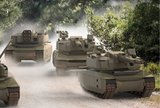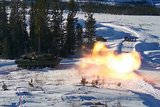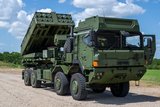Lockheed Martin supplies DCGS-A upgrade tools
Sorting through the massive amounts of operational intelligence available to those in theater is becoming easier as Lockheed Martin upgrades the data management and fusion capabilities of the enterprise that disseminates intelligence for the US Army. Through multiple projects, Lockheed Martin is modernizing many of the tools needed to support the Army's Distributed Common Ground System's (DCGS-A) intelligence missions.
DCGS is a family of systems that enables military analysts from all services to access shared intelligence. DCGS-A takes sensor data from all sources - signals, imagery and human intelligence - then integrates it into a common data format in a fused environment, making multi-source intelligence analysis possible.
"Army intelligence analysts increasingly rely on DCGS-A for their information and intelligence data," said Jim Quinn, vice president of C4ISR Systems with Lockheed Martin IS&GS-Defense. "Providing improved fusion and data management tools will enhance DCGS-A performance while reducing manual efforts that benefit both analysts and decision-makers across the Army, its coalition partners and the greater intelligence community."
Lockheed Martin is supporting the Army's efforts to modernize the capabilities of DCGS-A Version 3.1, currently fielded in Afghanistan. This software version's primary objective is to meet urgent operational needs for more and better intelligence. To ensure that intelligence is not corrupted or lost when transferred between heterogeneous intelligence systems, Lockheed Martin is incorporating a data management and transfer capability - Data Mover - which enables soldiers to move data between disparate databases while preserving data integrity and previously identified associations made through intelligence analysis. Another new capability automatically merges, or fuses, intelligence data, allowing objects and associations obtained from intelligence to be refined, giving soldiers a more coherent view of the battlespace.
Lockheed Martin is also modernizing the user interfaces and porting the software for the ACE Block II All-Source Fusion subsystem and the single source subsystem to a Linux platform. This will significantly reduce hardware and software sustainment costs and simplify operator workflows for both systems.
The DCGS enterprise is interconnected by a robust communications structure that enables seamless, real-time, multi-agency intelligence sharing and collaboration - DCGS Integration Backbone (DIB). Lockheed Martin is also upgrading the DIB, which supports real-time ISR data query and retrieval capabilities for the US and its coalition partners.
Source: Lockheed Martin
More from Land Warfare
-
![Rheinmetall and KNDS tank tie-up narrows trans-European options]()
Rheinmetall and KNDS tank tie-up narrows trans-European options
The French and German governments signed an agreement in June 2018 to cooperate on the development of a new main battle tank under the Main Ground Combat System programme but the effort has struggled. This new agreement may damage it further.
-
![2025 land market review: British Army woes, European heavy armour and US MBT progress]()
2025 land market review: British Army woes, European heavy armour and US MBT progress
The last year has seen several major procurements in the land market. Shephard’s Dr Peter Magill reviews the main trends and themes in land procurement of 2025.
-
![Hungary set to begin using Hero 400 loitering munitions]()
Hungary set to begin using Hero 400 loitering munitions
Developed by Israel's Uvision and with systems being sold in the thousands to multiple European NATO countries and the US, the Hero family of loitering systems is also in production in the US and Italy, the latter through Rheinmetall.
-
![Croatia orders Leopards and CAESAR howitzers as Lithuania orders more CAESARs]()
Croatia orders Leopards and CAESAR howitzers as Lithuania orders more CAESARs
The Leopard is becoming the tank of choice in central and eastern Europe as Croatia joins Lithuania, the Czech Republic and Hungary in ordering the platform. Lithuania and Croatia have also signed for CAESAR howitzers.
-
![Lockheed Martin to look further afield for GMARS rocket system opportunities]()
Lockheed Martin to look further afield for GMARS rocket system opportunities
The HX truck is already in use in many NATO and allied countries around the world as a logistics vehicle and carrier for high-value systems, including missile firing weapons, so its use for the Global Mobile Artillery Rocket System makes logistical sense.























